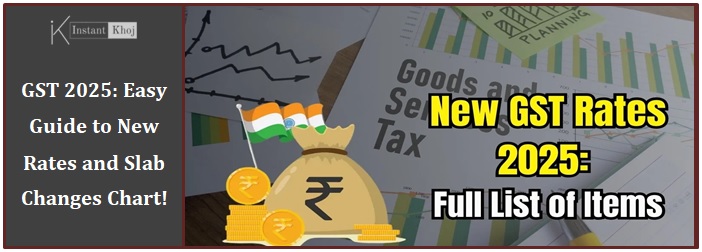From 22 September 2025, India’s Goods & Services Tax (GST) structure has been substantially overhauled. The government reduced complexity, reclassified many items, made essentials cheaper, and imposed higher taxes on luxury or “sin goods”. This article shows the changes by item, with comparison charts, and explains what this means for consumers.
What’s New in GST 2025
Before diving into goods & rates, here are the headline changes:
-
Two main slabs: 5% and 18% for most goods and services.
-
Essentials moved to 0% (nil GST).
-
Luxury or sin goods subject to a special high slab of 40%.
-
The older slabs of 12% and 28% are mostly eliminated (or reallocated).
Chart: Selected Goods — Old Rate vs New Rate
Below is a comparison chart for many goods, showing the old GST slab(s), the new slab, and whether the change makes them cheaper or costlier.
Good / Product Category | Old GST Rate(s) | New GST Rate (from Sept 22, 2025) | Change | Notes / Additional Context |
|---|---|---|---|---|
| Indian breads (roti, paratha, chapati) | 5% | 0% (nil) | Cheaper | Essentials fully exempted. |
| UHT milk, paneer, chhena (pre‑packaged/labelled) | ~5% or 12% for some label/packaged versions | 0% | Cheaper | Moves to nil GST for packaged UHT milk etc. |
| Butter, ghee, cheese, condensed milk | 12%‑18% | 5% | Cheaper | Sharply lower rate for many dairy & processed items. |
| Dry fruits, nuts, dates, etc. | ~12% | 5% | Cheaper | Lowered to 5%. |
| Namkeens, snacks (packaged) | 12‑18% | 5% | Cheaper | Many salty snacks get benefit. |
| Milk & dairy essentials & everyday food ingredients (starches, malt, etc.) | 12‑18% | 5% | Cheaper | Many packaged foods shifting down. |
| Toothpaste, shampoo, hair oil, soap, toothbrush | 18% | 5% | Cheaper | Essentials/personal care benefit. |
| Spectacles / goggles (vision correction) | 28% | 5% | Cheaper | Big drop for optical goods. |
| Cement, construction materials | 28% | 18% | Cheaper | Benefit in housing/construction. |
| Televisions, ACs, refrigerators, washing machines (high‑duty electronics) | 28% | 18% | Cheaper | Big appliances moved down. |
| Small cars, motorcycles ≤ 350 cc | 28% | 18% | Cheaper | Reduced tax for smaller vehicles. |
| Aerated drinks, sugary / carbonated / caffeinated beverages | Previously 18‑28% (plus cess) | 40% | More expensive | Classified under sin goods. |
| Motorcycles above 350 cc; luxury/SUV cars (high CC) | 28% + possibly heavy cess | 40% | More expensive | Premium vehicles now taxed heavily. |
| Pan masala, gutkha, tobacco products | 28% + cess (currently) | 40% (once cess obligations cleared) | More expensive / stays high for now | These are part of the sin goods list. |
| Yachts, aircraft (personal) | ~28% + cess / luxury tariff | 40% | More expensive | Premium private use items moved into sin slab. |
Legend: Cheaper = you’ll pay less GST or none; More expensive = rate increased, taxed heavier.
Chart: Proportion & Shift of Goods from Old Slabs
Here’s an approximate view of how many items moved from old slabs into the new ones, based on sectors / categories.
Old Slab / Category | Many Goods Moved To… | Effect for Consumers |
|---|---|---|
| 12% slab (processed foods, dairy, personal care, etc.) | Mostly to 5% or 0% | Significant drop in cost on many grocery / daily use items. |
| 5% slab (basic foods, some dairy) | Some items to 0% | Essentials fully exempted. |
| 28% slab (luxury goods, vehicles, electronics etc.) | Most → 18%, some → 40% | Big items cheaper; luxury / sin items more costly. |
What “Sin Goods” Are & What’s in the 40% Slab
“Sin goods” are goods considered harmful to health or society. Under GST 2025, they attract the 40% slab. Here’s what this includes:
-
Aerated / carbonated / sugary drinks; caffeinated beverages.
-
Motor vehicles (cars / SUVs) with high engine capacity, motorcycles above 350 cc.
-
Luxury items: yachts, private aircraft, leisure boats.
-
Tobacco, pan masala, gutkha, etc. (though some continue under old rates + cess until formal transition).
Deep Dive: What Moves to Which Slab + Why
Let’s go through more items in detail, what they were, where they are now, and key rationale.
Essentials & Food Items
-
What changed: Many food items that had 12‑18% GST (e.g. biscuits, snacks, sauces, pastas, dry fruits) are now in 5% slab.
-
Zero‑rated: Indian breads, UHT milk, paneer etc. are now nil GST.
-
Why: To control living cost, especially for middle & lower income families; reduce inflationary pressure. Ensuring food staples are more affordable.
Personal Care & Household Items
-
Items like soap, shampoo, hair oil, toothbrushes moved from 18% to 5%.
-
Other home‑use goods (utensils, non‑electric kitchenware, water filters etc.) also benefit.
Big Ticket / Durable Goods, Automobiles & Housing
-
Appliances & electronics: Televisions, ACs, fridges etc. move from higher rates (28%) to 18%. Cheaper for buyers.
-
Small cars, motorcycles under certain cc thresholds → 18% instead of 28%. Reduces cost of ownership for many.
-
Construction materials like cement drop to 18%. Helpful for real estate, infrastructure.
Luxury & Sin Goods
-
These goods are not made cheaper; many are made more expensive via 40% slab.
-
Affected goods: sugary / fizzy beverages; high CC vehicles; yachts; tobacco etc.
Implications & What Consumers Should Expect
Putting all these changes together, what do these mean in practice?
-
Cost Savings on Everyday Purchases
For groceries and daily essentials: households will see noticeably lower GST components. If an item was taxed at 12‑18%, moving to 5% or 0% means savings. -
Big Purchases Get Cheaper
Buying electronics or vehicles will be more affordable, especially smaller cars, household appliances. -
Luxury / Sin Goods Costlier
If you buy sugary drinks, premium cars, etc., you will be paying considerably more under the 40% slab. -
Inflation Relief
These changes are intended to pull down inflation of essential goods. -
Complex Jurisdiction / Transition Effects
Some items may still carry old GST + cess till obligations (like compensation cess) are cleared. Also, the cost drop might not pass fully to consumers immediately (logistics, retailer markup etc.).
Full-ish Itemised List (Grouped by Slab)
To help you see more clearly, here is a grouped list of many items under each new slab, based on available sources. This is not fully exhaustive, but covers many commonly used goods.
0% Slab (Nil GST) | 5% Slab | 18% Slab | 40% Slab (Sin / Luxury Goods) |
|---|---|---|---|
| Indian breads (roti, paratha, etc.) | Butter, ghee, cheese, condensed milk | Televisions, ACs, refrigerators | Sugary / aerated / caffeinated beverages |
| UHT milk, paneer, chhena for packaged / labelled goods | Dry fruits, nuts, dates; sausages; malt, starch products | Small cars, motorcycles ≤ 350cc | Motorcycles above 350cc; large engine‑capacity cars / SUVs |
| Life‑saving medicines / some medical devices | Snacks, sauces, pastas, noodles, namkeen | Cement, construction materials | Tobacco, pan masala, gutkha, cigarettes (once fully shifted) |
| — | Personal care (soap, toothpaste, shampoo etc.) | Appliances, electronics for everyday/durable use | Yachts, aircraft for private use |
Why These Changes?
Summarising the rationale helps make sense of the shifts:
-
Simplicity: Earlier many slabs (5, 12, 18, 28) made classification tricky; disputes & compliance burdens were high. Simplifying to mostly 5% and 18% + special 40% for luxury/sin goods reduces complexity.
-
Relief for Common Consumers: Essential goods and daily use items are cheaper. Helps reduce cost of living.
-
Encouragement of Domestic Demand: Lower taxes on appliances, vehicles etc. to boost consumer demand.
-
Public Health & Progressive Taxation: High rates on “sin” or harmful items discourage consumption and help raise revenue from those who can pay more.
Possible Challenges / Things to Watch
-
Not all goods transition immediately. Some sin goods may stay under old GST + compensation cess until legal or fiscal obligations are resolved.
-
Retailers, wholesalers need to update billing, inventory, pricing — transitional delays may cause inconsistent price changes.
-
In some cases, only the GST component is reduced; other costs (transport, logistics, etc.) remain, so final consumer price may not fall by full theoretical margin.
-
Consumer expectations might overshoot; while many prices drop, some may only reduce marginally.
Conclusion
The GST Reforms of 2025 mark one of the most sweeping tax‑changes in recent memory in India. With the introduction of the simpler slab structure (0%, 5%, 18%, 40%), the government aims to lighten the load on everyday essentials, stimulate consumption and demand, while ensuring luxury/sin goods carry a heavier burden.
From 22 September 2025, you’ll see many daily goods (food, dairy, personal care) becoming noticeably cheaper, big appliances & vehicles more affordable (if not premium/high engine ones), and sin / luxury products becoming more expensive.





One thought on “GST 2025: Easy Guide to New Rates and Slab Changes Chart!”